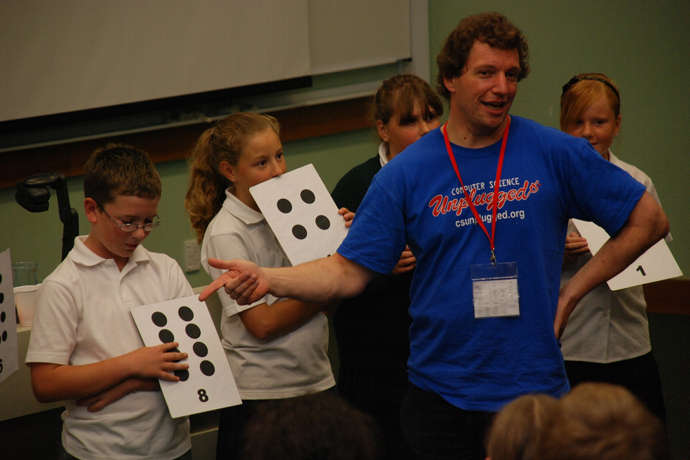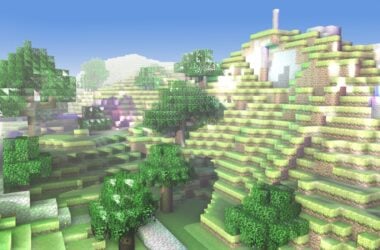If you’re a teacher, parent, or a student, where would you start to learn about what to teach about computer science to young kids?
In the United States, there are at least two standards, one from the Computer Science Teachers Association (CSTA) and one from the International Society for Technical Education (ISTE). Both provide excellent start points for students and parents who want to learn what might be age appropriate. Both these standards are created by teachers, designed carefully, and linked to other standards, for example, Common Core in the US.
So what is in these standards? Here is a high level view to show how they teach kids about computer science.
CSTA
The CSTA standards are organized into three levels based on age and grade level:
- Computer Science and Me (Grades K-6) — Students mix basic technology skills with simple computational thinking ideas. Learning experiences should be inspiring and engaging to help kids see computing as important in their world. Kids should engage in active learning, creativity, and exploration, often by embedding computer science with social science, language arts, math, science, and other curriculum.
- Computer Science and Community (6-9) — Students begin to use computational thinking to solve problems. They learn how computer science helps communication and collaboration between people and groups. Students learn to see themselves as proactive and empowered problem solvers. Kids should engage in active learning, creativity, and exploration with computer science information embedded in their other courses.
- Computer Science in Modern World, Concepts and Practices, and Computer Science Topics (9-12) — At this level, students learn computer science as three distinct but related courses which highlight different facets. They master more advanced concepts then apply those concepts to create artifacts. Kids engage in collaborative learning, project management, and effective communication.
The CSTA standards also include five strands present through all three levels of their standards, from kindergarten to senior year of high school:
- Computational Thinking — CT can be used across all disciplines to solve problems, design systems, create new knowledge, and improve the understanding of the power and limits of computing. Students learn to conceptualize, analyze, and solve complex problems by selecting and applying appropriate strategies and tools. They use a set of concepts, for example, abstraction, recursion, and iteration, to process and analyze data and create artifacts.
- Collaboration — Typically computing projects involve many people who work together to design, code, test, debug, describe, and maintain software. Students learn to work together to gather information and communicate with others to identify and solve problems.
- Computing Practice and Programming — This includes the ability to create and organize web pages, explore how programming can solve problems, select appropriate programming languages and data storage as tools, and use appropriate tools and libraries to help solve problems.
- Computers and Communication Devices — Students should understand how the internet facilitates global communication and how to be a good citizen online. They also learn appropriate and accurate terminology when communicating about technology.
- Community, Global, and Ethical Impacts — The ethical use of computers and networks is a key aspect of computer science. It is an essential element of both learning and practice. Students learn the norms for ethical use of the internet, for example, principles of privacy, respect for others, network security, software licenses, and copyright. They also learn to evaluate the reliability and accuracy of information they receive from the internet. Ethics also includes the distribution of technology which raises questions about equity, access, and power.
ISTE
ISTE standards are organized for students (Standards*S), teachers (Standards*T), administrators (Standards*A), coaches for digital educators (Standards*C), and computer science educators (Standards*CSE).
For example, the teacher standards include:
- Facilitate and inspire student learning and creativity in face to face and virtual environments. This includes thinking in innovative ways to solve problems, engage students with real life issues, promote reflect with collaborative tools, and knowledge construction with digital tools.
- Design and develop digital age learning experiences and assessments. Teachers develop technology-enriched learning environments students can use to pursue their curiosity and set their education goals then manage and assess their learning process, as well as working with diverse learning styles and providing assessments to students.
- Teachers model digital age work and learning by exhibiting knowledge, skills, and work processes used by professionals in a global and digital society. Teachers should demonstrate fluency in technology systems., collaborate with students, peers, and their communities to support student success and innovation.
- Promote and model digital citizenship and responsibility. This includes teachers understanding local and global social issues and responsibilities in an evolving digital culture, as well as exhibit legal and ethical behavior online.
- Engage in professional growth and leadership, including demonstrating a vision of shared decision making and community building. Teachers also should contribute to the effectiveness, vitality, and self-renewal of the teaching profession, their school, and their community.
The standards for students and others mirror these teacher standards. For example, parents can find direction about what topics might be appropriate for their children if they want to find activities they can share at home.
Translation: One Example
It takes time and effort to translate standards into real world actions. If you are a parent, or a teacher, how would you translate any of these standards into specific actions?
Because I have more experience translating the CSTA standards into editorial guidelines for stories in this magazine, I would focus on one strand of the CSTA standards.
Imagine you have a five year old child playing a maze game on a tablet computer.
With the CSTA standards, the child would be at the Computers and Me level, and ideally suited to experiences that involve active learning, creativity, and exploration. You might sit with the child as they work through a maze and quietly watch as they make choices. You might ask them periodically about their choices: What did they want to accomplish? What did they think would happen? What did happen? What might have happened? Get the child to think about their activity as both stream of consciousness and deliberate actions to achieve goals, in a way that engages and inspires them to try more.
This process helps the child develop an awareness of problems, resources available to help solve a problem, and possible solutions.
Speaking as a parent, it’s also important to let the child drive. Instead of saying, “Let me show you” then taking control of the game, instead ask, “Can I show you to do x?” where x is a specific task or result. Children need to learn how to take charge and give up control, both critical skills when working with other people.
Learn More
CSTA
http://csta.acm.org
http://csta.acm.org/Curriculum/sub/CSK8.html
http://csta.acm.org/Curriculum/sub/K12Standards.html
http://csta.acm.org/Curriculum/sub/CompThinking.html
http://csta.acm.org/Curriculum/sub/CurrResources.html
K—8 Computer Science: Building a Solid Foundation (CSTA)
http://csta.acm.org/Curriculum/sub/CurrFiles/CS_K-8_Building_a_Foundation.pdf
K—8 Research Reading List (CSTA)
http://csta.acm.org/Curriculum/sub/CurrFiles/K-8CSReadingList_Research.pdf
ISTE
http://www.iste.org/standards/standards-for-students
http://www.iste.org/standards/standards-for-teachers
http://www.iste.org/standards/standards-for-administrators
http://www.iste.org/standards/standards-for-coaches
http://www.iste.org/standards/standards-for-computer-science-educators










